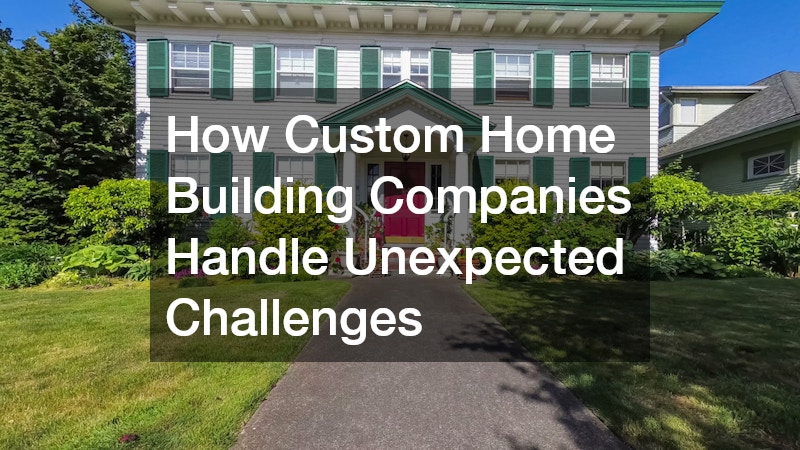This article explores how custom home building companies navigate the complexities and unexpected challenges that arise during the construction process. Building a custom home is a journey filled with excitement, creativity, and an array of decisions. However, the path to creating a dream home is rarely a straight line.
Builders often face obstacles that can disrupt timelines and budgets, making it essential for them to be equipped with the tools and strategies needed to address these challenges head-on.
What are the most common unexpected challenges faced by custom home builders?
One of the most prominent challenges is adverse weather conditions, which can stall construction schedules and result in cost overruns. Builders must be adept at predicting weather patterns, planning for seasonal variations, and identifying potential delays that can affect their timelines.
Additionally, supply chain issues have become increasingly common in recent years. Builders often face shortages in essential materials, leading to delays as they search for alternative suppliers or products. These disruptions can significantly impact the construction schedule, increase costs, and require adjustments in project planning, making efficient supply chain management crucial for a successful project.
Furthermore, unforeseen site conditions can arise unexpectedly during construction. For example, builders may encounter unanticipated soil conditions, hidden utility lines, or environmental concerns that necessitate additional work. These challenges require a builder’s quick thinking, problem-solving skills, and flexibility to find effective solutions without derailing the project or compromising quality.
How do custom home builders mitigate risks and prepare for challenges?
One key strategy employed by custom home builders is comprehensive project planning. This involves creating a detailed construction schedule that anticipates potential problems and incorporates buffer time for unforeseen delays, minimizing disruptions.
Another essential aspect is maintaining a flexible approach. Builders often establish contingency plans that allow them to pivot quickly when challenges arise. Whether it means sourcing alternative materials, adjusting timelines, or reallocating labor resources, adaptability can be critical in keeping projects on track.
Finally, leveraging technology can further enhance preparation and risk mitigation. Many builders utilize project management software that provides real-time updates on timelines, costs, and resource allocation. These tools facilitate better decision-making, streamline communication, and improve the overall efficiency of the construction process.
What role does communication play in addressing unexpected challenges?
Effective communication is crucial in managing expectations and keeping everyone informed throughout the construction process. Regular updates, detailed progress reports, and open dialogues can help to mitigate client anxieties and foster a sense of trust, ensuring that all stakeholders feel confident in the project’s direction.
Additionally, strong communication with subcontractors ensures that all parties are aligned on project goals and timelines. When challenges arise, quick discussions and collaborative problem-solving can lead to immediate solutions, preventing minor issues from escalating into significant problems. Coordinating effectively with subcontractors, suppliers, and on-site teams is often key to addressing delays or changes promptly and maintaining overall workflow efficiency.
Moreover, fostering an environment where feedback is encouraged can lead to continuous improvement. Builders who actively solicit input from their teams and clients can identify potential problems early on and implement effective solutions collaboratively. Transparent communication also allows for adjustments in design, materials, or scheduling before issues become costly. This emphasis on communication strengthens relationships, streamlines the construction process, and builds a culture of accountability, ultimately contributing to a successful project outcome.
How do custom home building companies adapt to changing regulations and industry standards?
The construction industry is subject to a myriad of regulations that are frequently updated to address safety, environmental, and zoning issues. Builders must stay informed and adapt their practices accordingly to avoid potential penalties, delays, or compliance complications.
Continuous education and training play a critical role in helping builders navigate complex regulatory environments. Many companies invest in professional development, workshops, and certifications for their staff to ensure they are knowledgeable about the latest codes and standards impacting their projects. Staying ahead of these changes is vital for maintaining compliance, protecting clients, and ensuring the safety of construction sites.
Additionally, working closely with local authorities, industry organizations, and trade associations can enhance builders’ capacities to understand and implement necessary adjustments efficiently. Builders who actively participate in industry discussions, attend regulatory briefings, and engage with governing bodies are better positioned to anticipate changes and develop proactive strategies. This approach allows companies to implement updates seamlessly, minimize disruptions, and continue delivering high-quality homes that meet or exceed current legal and safety requirements.
Custom home building companies must be agile and resourceful to handle the unexpected challenges that can arise, ultimately ensuring a successful project outcome. By anticipating potential issues, maintaining clear communication, and remaining adaptable to changes in regulations, these companies can navigate the complexities of home building with resilience and efficiency. The process may be fraught with hurdles, but a proactive approach can make all the difference in bringing a client’s vision to reality.
